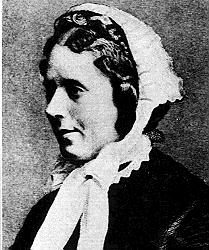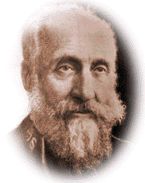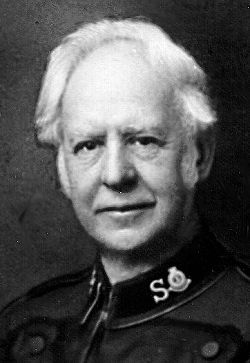 "The Founder"
"The Founder"William Booth
Thousands of Salvationists through the years have made The Salvation Army what it is. However, four people laid the foundation on which all later Salvationists built.
William Booth • Catherine Booth • George Scott Railton • Bramwell Booth • The foundation
 "The Founder"
"The Founder"William Booth was born in Nottingham, England. He was acutely aware of the poverty in which people lived and how they suffered humiliation and degradation because of it. He was converted in 1844, and soon was involved in evangelistic work. In 1854, he was accepted on probation as a Methodist minister and was ordained in 1858. After his marriage to Catherine Mumford in 1855 he spent several years as a minister of the Methodist New Connexion [denomination]. However, he was unhappy as a pastor and wanted to dedicate himself to evangelistic work. He resigned his position, and settled in London with his family, preaching in the streets of the East End. Some missioners were so impressed by his powerful preaching that they asked him to lead meetings they were holding. Booth soon realized he had found his destiny and formed his own movement, which became The Salvation Army. His book, In darkest England and the way out, setting forth his vision for social reform, was published in October 1890. The book became the blueprint for the Army's social services. By the time Booth was "promoted to Glory" in 1912 the Army was at work in 58 countries.
 "The Army
Mother"
"The Army
Mother"January 17, 1829 - October 4, 1890
Catherine Mumford was born in Ashbourne, Derbyshire. In 1846, she was converted. She was seriously ill for much of her youth, but she kept herself busy studying the Bible and theology. Her correspondence with William Booth during their engagement was unusually frank for the Victorian age. On June 16, 1855, they were married. Her first pamphlet, "Female ministry," was published in December 1859. Although she was a strong supporter of women's right to preach the Gospel, her first public address did not occur until May 27, 1860. She and William had eight children, all of whom dedicated their lives to Christian work. When the work of The Christian Mission began, William preached to the poor and ragged and Catherine spoke to the wealthy, gaining support for their financially demanding work. Although her health continued to be poor, she addressed large public meetings throughout Britain. She was behind many of the changes in the new movement, designing a flag, the women's bonnet, and contributing to the Army's ideas on many important issues. Because of her theological studies, she was instrumental in establishing the Army's beliefs. When she died in 1890 it was a great loss. Her life had been a challenge to thousands who remembered her as an untiring soldier in God's Army.
 George Scott Railton
George Scott Railton
![]() The
son of a Methodist minister, he lost both parents from fever when he was
15. The boy worked on his own in London, seeking something that was more
like the old Methodism of John Wesley. Eventually, he found the Christian
Mission work of William Booth. At the Booths' invitation, he moved into their
home to become Secretary of the Christian Mission. In this position, he
contributed much to the beliefs and methods of the fledgling Salvation Army.
He also served as a trouble-shooter for the Founder. Ascetic by nature, he
was impatient with anything he considered compromise of standards or lessening
of devotion to God and the Army. By 1880, William Booth's son
Bramwell succeeded him as Secretary ("Chief of the
Staff"). Railton, who always had a desire for mission work, persuaded Booth
to assume control of the new Salvation Army work in
the United States. By 1881, he was needed
by Booth and was on his way to begin missionary work in other lands. A talent
for languages enabled him to create confidence in educated people. Somehow,
he found time for courtship and marriage to Marianne Parkyn, a soul mate
who proved adaptable to his frantic schedule and incessant traveling away
from England. Railton was inspired by the missionary spirit in a far wider
sense than is generally understood. He was a missionary not for a province,
land, or people, but for the world. Although his health began to fail noticeably
after the Founder's death, he kept up his frantic schedule. After running
for a train in Cologne, Germany, he collapsed and died at the age of 64.
He was laid to rest beside The Salvation Army's Founder.
The
son of a Methodist minister, he lost both parents from fever when he was
15. The boy worked on his own in London, seeking something that was more
like the old Methodism of John Wesley. Eventually, he found the Christian
Mission work of William Booth. At the Booths' invitation, he moved into their
home to become Secretary of the Christian Mission. In this position, he
contributed much to the beliefs and methods of the fledgling Salvation Army.
He also served as a trouble-shooter for the Founder. Ascetic by nature, he
was impatient with anything he considered compromise of standards or lessening
of devotion to God and the Army. By 1880, William Booth's son
Bramwell succeeded him as Secretary ("Chief of the
Staff"). Railton, who always had a desire for mission work, persuaded Booth
to assume control of the new Salvation Army work in
the United States. By 1881, he was needed
by Booth and was on his way to begin missionary work in other lands. A talent
for languages enabled him to create confidence in educated people. Somehow,
he found time for courtship and marriage to Marianne Parkyn, a soul mate
who proved adaptable to his frantic schedule and incessant traveling away
from England. Railton was inspired by the missionary spirit in a far wider
sense than is generally understood. He was a missionary not for a province,
land, or people, but for the world. Although his health began to fail noticeably
after the Founder's death, he kept up his frantic schedule. After running
for a train in Cologne, Germany, he collapsed and died at the age of 64.
He was laid to rest beside The Salvation Army's Founder.

March 8, 1856 - June 16, 1929
William Bramwell Booth was the eldest son of William and Catherine Booth. He served as his father's Chief of the Staff from 1880 to 1912. He was largely responsible for the organizational development of the Army. He also encouraged the development of the Army's youth work. His teaching of the doctrine of holiness and his councils with officers and young people were of incalculable value. In 1882, he married Captain Florence Soper.
In 1912, he succeeded his father as General. During his term, impetus was given to missionary work. In 1929, he was forced to retire because of ill health, and died shortly thereafter.
William Booth gave The Salvation Army both passion and compassion — a fire for souls, an undivided concern for both the spiritual and material well-being of humanity. However, the Founder was an evangelist, not a theologian. Catherine Booth laid the Army's doctrinal foundation — purity of heart and life, a practical religion that expressed itself in both devotion and service, and that reached to every part of the Salvationist's life. Railton gave the Army vision and dedication — the courage to reach out in new directions, to carry the work wherever there was need — singleness of purpose, the ability to strive toward the goal without deviation or distraction. Bramwell Booth laid the organizational foundation — a combination of flexibility and discipline that can swiftly react to need but maintain a singleness of purpose and identity. In these ways, our founders laid the foundation for all that The Salvation Army would become.
History main page |
Salvation Army history |
Beginnings |
 Last
revised: 7/17/2002
Last
revised: 7/17/2002
© 1999-2002
• Founders • Beginnings • The Army comes to America • National developments • International developments• Sources • International Heritage Centre website